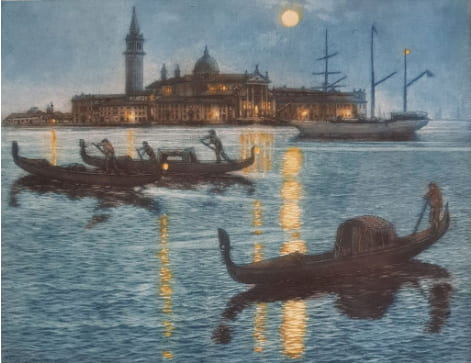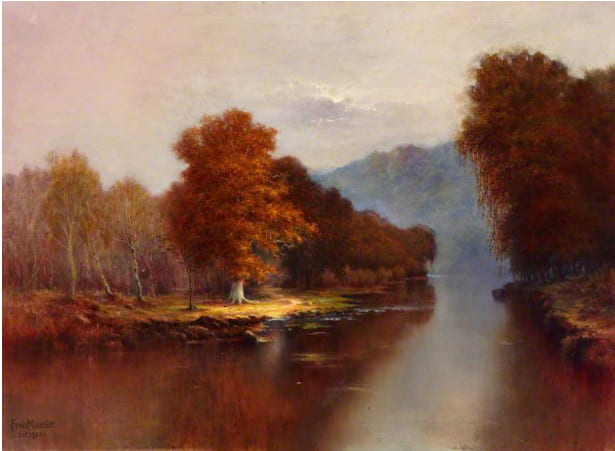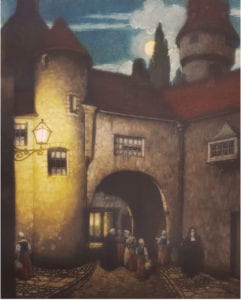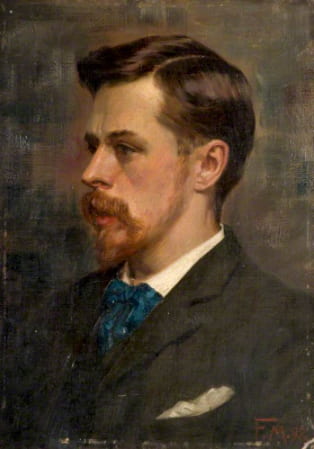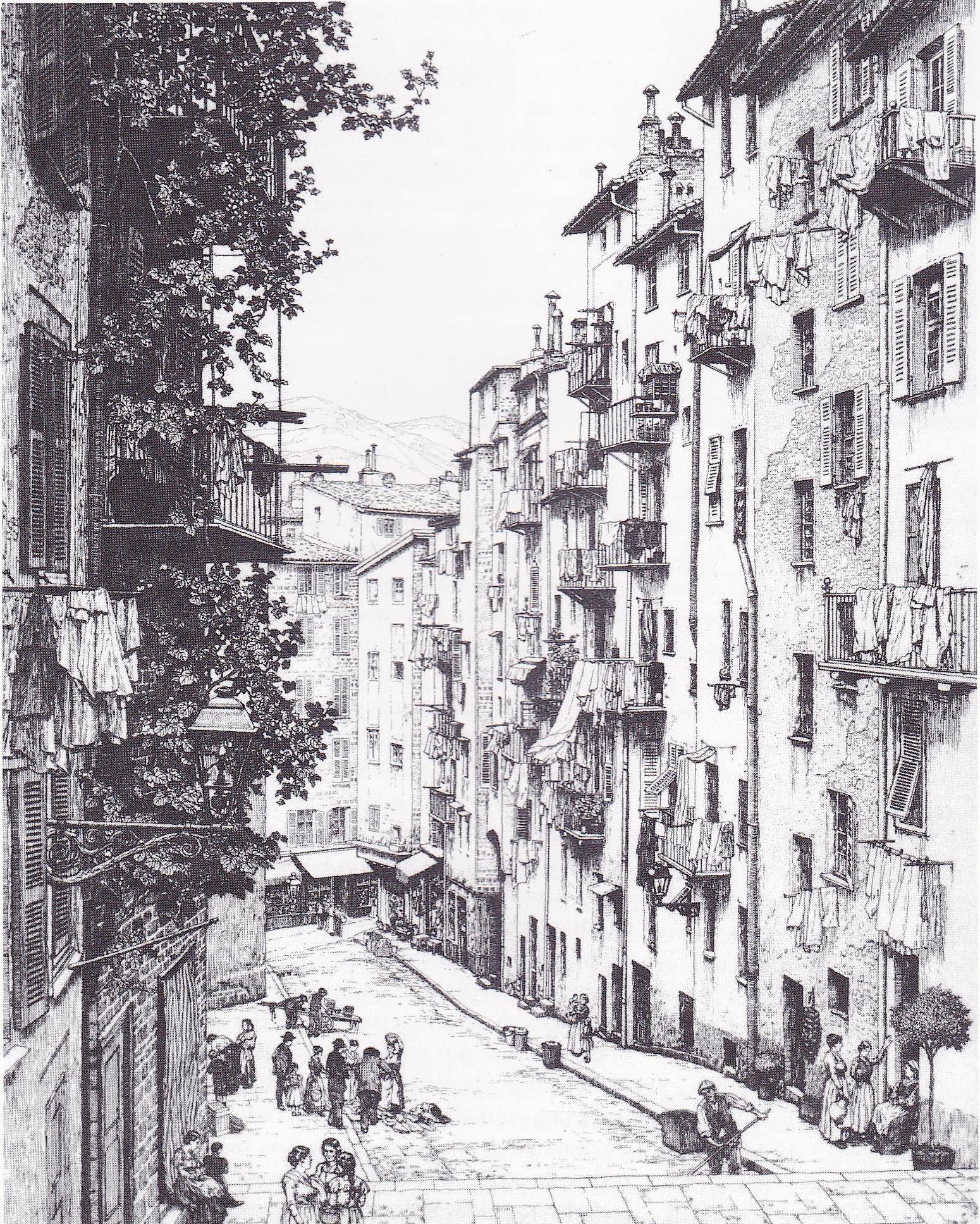
Rue Gubernatis, Nice, Etching by Frederick Marriott. Image: Goldsmiths Art Collection.
It is not widely known that the teaching of Art at Goldsmiths predates the beginning of the life of the College as part of the University of London in 1905.
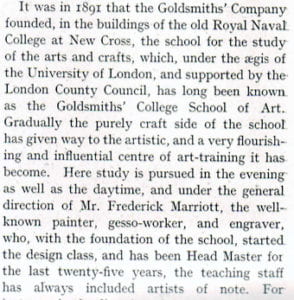
‘Studio’ Magazine profiled the Goldsmiths’ College Art School in 1918 and described Marriott as ‘the well-known painter, gesso-worker, and engraver.
The Art School started with the creation of the Goldsmiths Company’s Technical and Recreative Institute in 1891, and its first head teacher was an artist friend of the famous writer Arnold Bennett.
Like Bennett, Frederick Marriott was born in the potteries in Stoke on Trent in 1860.
His father was an engine fitter.
He became a respected painter and etcher of landscapes, architectural subjects and portraits.
He lived most of his life, like many other Goldsmiths’ artists and teachers, in Chelsea.
His address for nearly 40 years was 6A Netherton Grove, Chelsea, a quiet road bordering St Stephen’s hospital, entered and exited only by the Fulham Road, and a stone’s throw from the working class slum terraces of Slaidburn Street and the World’s End.
The first history of Goldsmiths published in 1955, ‘The Forge,’ said that when he retired in 1925, he was regarded as ‘the well-loved Head of the School of Art since its inception in 1891 and had established its excellent reputation as a Fine Art School.’
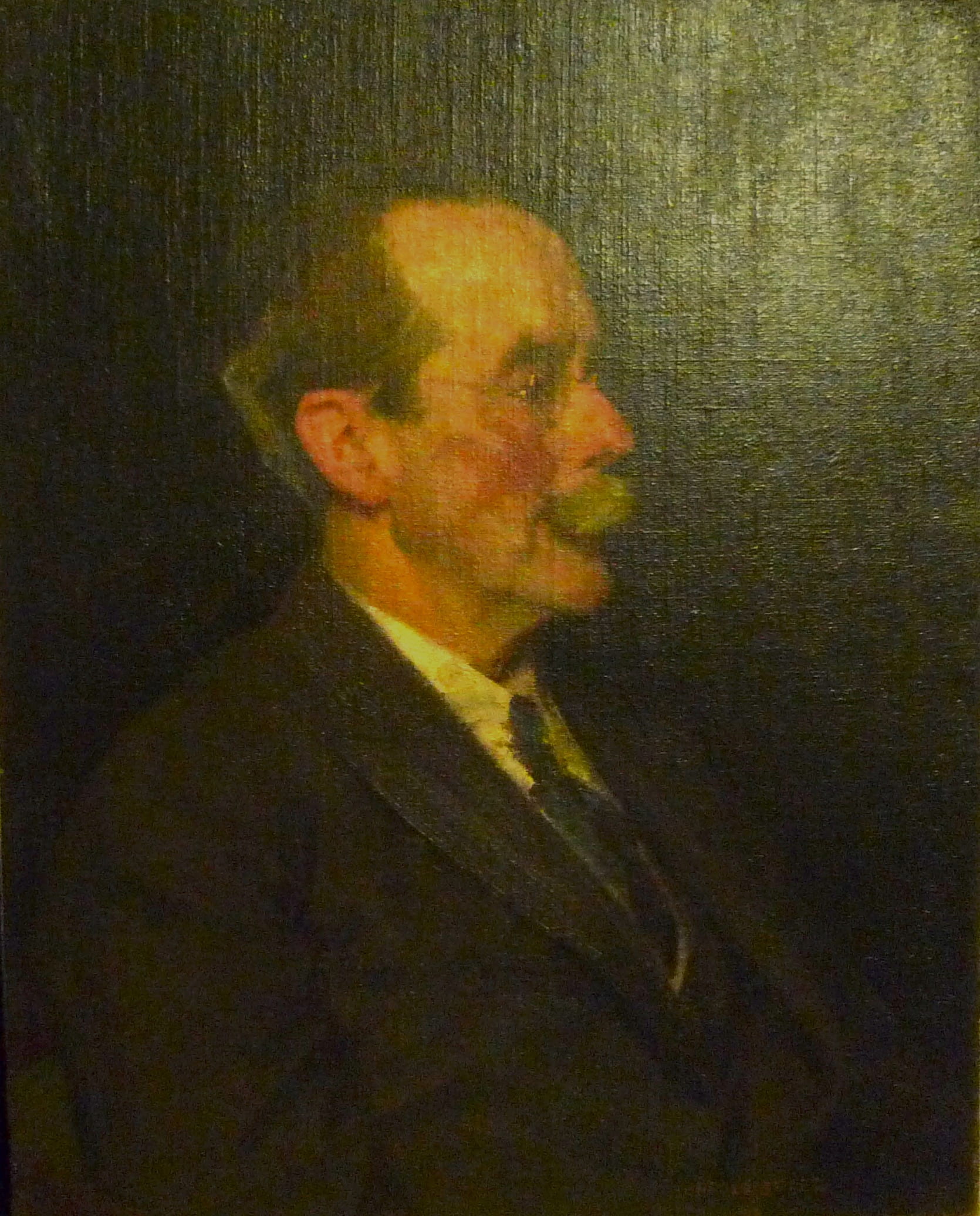
Official Goldsmiths’ College portrait of Frederick Marriott painted by Harold Speed in 1925. Image: Goldsmiths, University of London Archives.
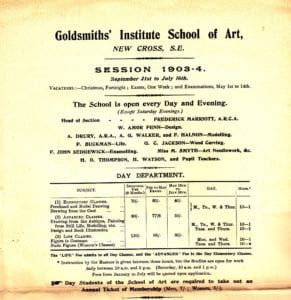
Brochure for the Goldsmiths’ Institute School of Art, Session 1903-4. Frederick Marriott was the only full-time member of staff. Classes were offered during the day and evening.
His portrait was painted by the artist Harold Speed, who had been in charge of portrait painting at the College since 1908.
For many years it hung in ‘the conference room’, but has since been relegated to storage for the College art collection.
The Delegacy (University of London management committee running Goldsmiths) ‘placed on record their high appreciation of his eminent services at New Cross for thirty-four years.’
The second Goldsmiths’ history written by Anthony Firth and published in 1991 was more critical:
‘Marriott was a lively figure and a close friend of Arnold Bennett. But he, and his successor as Headmaster, W. Amor Fenn (1925-9) had worked at New Cross from 1891. It seems clear that the work of the School under their direction did not change much in its early years as part of Goldsmiths’.
Marriott and Amor Fenn were both engravers, and students seem to have been encouraged to specialise in that area of work.’
Firth complains that the school had not moved very far in the direction of ‘higher education in art’ which had been the hope of the Delegacy and new funding body, the London County Council in 1906.
Graham Sutherland joined as a student in 1921 and in 1963 he recalled:
“While the teaching at the school was probably sound and was certainly practical, it was totally out of touch with the great European movements, then in full flower and moving to a climax. If Old Masters’ names were heard I do not remember much serious attempt being made to implant any real understanding of the significance of their work.”
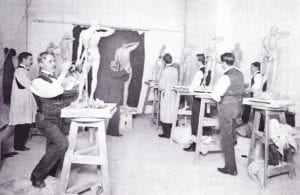
A life class at the Goldsmiths’ Company Institute in the late Victorian and early Edwardian age. The artist Graham Sutherland thought the Art School was old-fashioned by the time he enrolled in 1921.
“Still less were we really taught to apply their example to our own work. I do not remember hearing a word about the Impressionists and on the subject of the Modern Movement there was a profound silence.”
New blood and ideas would be introduced when Clive Gardiner started teaching there from 1918. He would be appointed Headmaster in 1929.
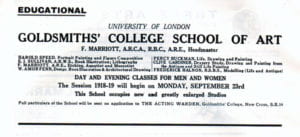
By 1918 Frederick Marriott is now Headmaster of the Goldsmiths’ College School of Art. The advertisement in ‘Studio’ Magazine shows that the young Clive Gardiner has joined the team of visitor tutors teaching Drapery Study, Drawing and painting from the Antique and Still Life Painting. Image: Goldsmiths Archives.
Marriott received his early training in the school of Art, Coalbrookdale, and at the age of 14 went to work as a pottery painter in a factory.
In 1879 he gained a National Scholarship to the Royal College of Art in Kensington where he studied for three years.
He then worked as a designer and illustrator to Wood and Sons potteries company.
Later he became Chief Designer with the publisher Eyre and Spottiswood working there for four and a half years.
He practised repoussé work, wood carving, enamelling and modelling, and produced some fine panels in modelled gesso with mother-of-pearl inlay.
He exhibited at the Royal Academy (R.A.), Royal Society of Painter-Etchers and Engravers (R.E.), in the provinces and at the Paris Salon.
He was in every way a striking character: five feet tall, handlebar moustache, a regular wearer of a Norfolk jacket, and charming sense of humour.
Jolyon Drury, in his book Revelation to Revolution: The Legacy of Samuel Palmer, The Revival and Evolution of Pastoral Printmaking by Paul Drury and the Goldsmiths School in the 20th Century offers a delightful account of Marriott’s introduction of Paul Drury to Graham Sutherland in 1921:
‘Frederick Marriott was showing Graham Sutherland and his rather ‘starchy’ father (‘a tall gentleman of evident distinction’) round the art school one day in September 1921, when they came upon Paul Drury in the smaller studio painting an ‘old salt’, a bargee, from a drawing from life. “This is the room” remarked Marriott to Sutherland Snr. “where students can get on with composition and have a nodding acquaintance with Mr. Yorrick [in the corner was a skeleton in its little sentry box]…he seldom answers but he always smiles.” “This is Drury’s little boy” Marriott continued, “known him since he was a baby. Did Drury send his son to the Slade? Or to the Academy Schools? No, he sent him here.”‘
His work in public collections includes a commission of a small painting in the Royal Collection, called Normandy House circa 1923. It is a night scene with a gabled farmhouse, towers to the right and two figures at the door. This was commissioned for The Library in Queen Mary’s Dolls’ House.
He was Design Master at Blackheath School of Art, and head of art teaching at the Onslow College of Science and Technology, 183 King’s Road, Chelsea.
He served as Headmaster of the Art School at the Goldsmith’s Technical and Recreative Institute from 1891 to 1904 and then continued in the same role with the Art School when it became part of University of London, Goldsmiths’ College until 1925.
He made continental tours working on town scenes with the emphasis on architecture, and also visited and painted in Australia about 1910 when he was given leave by Goldsmiths’ College to visit relatives.
Although having been very much lost to history for many years, and not being particularly referenced in terms of art historical prominence, there are signs that his work and contributions to culture are gaining capital in auctions and the interest of scholarship.
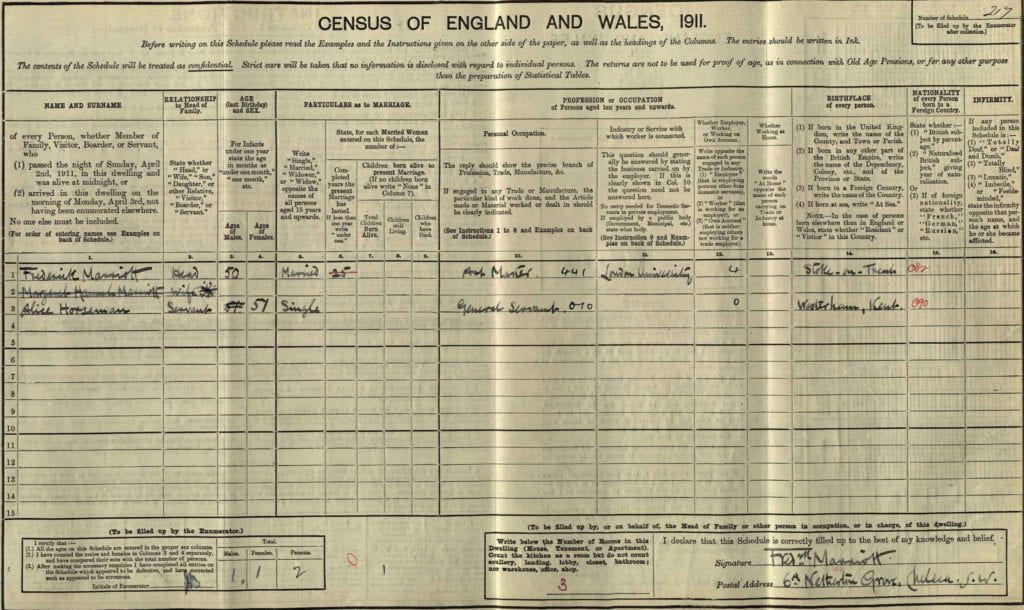
Frederick Marriott census return for 1911. He was living at 6A Netherton Grove, Chelsea and describes himself as an ‘Art Master.’ By this time he was Headmaster of the Art School at University of London, Goldsmiths’ College. The London County Council had taken over the funding of the School from the Goldsmiths’ Company of the City of London in 1905-6. The Census Return has been filled in by him in his distinctive handwriting.
In particular, Keele University Library has a considerable number of valuable and informative papers in their Arnold Bennett collection originated and authored by Frederick Marriott.
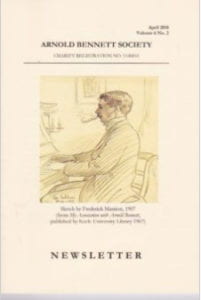
Cover for Arnold Bennett Society Newsletter for April 2018 Vol 6 No. 2. Click through for image origin.
Its most interesting archive treasure is a charcoal portrait of Arnold Bennett by his friend Frederick Marriott in 1907 which was recently used to illustrate the front cover of an edition of the Arnold Bennett Society
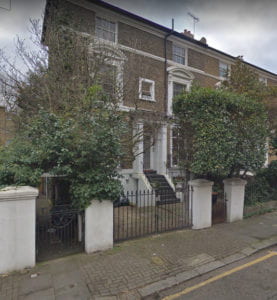
6A Netherton Grove in Chelsea in 2018- Frederick Marriott’s home throughout his time when Headmaster of Goldsmiths’ College Art School and where he and his wife entertained Arnold Bennett during the early part of the 20th Century. Image: Google Street View.
Journal/Newsletter.
The Arnold Bennett collection of archives at Keele University holds some important papers written by Marriott in respect of his relationship with Arnold Bennett.
They include the manuscript ‘Adventures with Arnold Bennett’ and a 68 page memoir titled ‘My Association with Arnold Bennett.’
For the period between 1911 and 1929 there are eight letters and 18 postcards from Arnold Bennett and Marguerite Bennett) to Mr and Mrs Frederick Marriott and others.
There is also a delightful archive document of poetic tribute: ‘Rhyming couplets on Arnold Bennett’ written by Frederick Marriott.
John Shapcott, ‘Literary scholar & editor – Arnold Bennett, regional novels, silent films, Melvyn Bragg. Honorary Research Fellow, Keele University,’ is currently carrying out research on the friendship and association between Arnold Bennett and Frederick Marriott.
That’s So Goldsmiths– a forthcoming history of the university is being researched and written by Professor Tim Crook.
